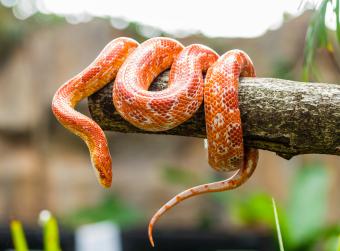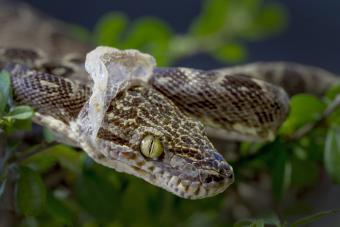
Reptiles are fascinating creatures. They can range from tiny and harmless to enormous and terrifying, with a wide variety of shapes and colors. Reptiles also have many different reproductive strategies that evolved over millions of years in order to help them survive in harsh environments. In addition, reptiles have a variety of methods of reproduction. Reptiles lay eggs, have live births, and can reproduce asexually. Some species of lizards lay eggs in holes they dig in the ground. Turtles lay their eggs on land, often in sandy areas close to water so baby turtles can easily reach water when they hatch.
Internal Fertilization
Reptiles are typically cold-blooded and reproduce sexually through internal fertilization. Reptiles lay eggs, but some species give live birth, as well. Reptile egg-laying is not necessarily random; most lizards lay eggs in nests made by the female. The female may even protect the eggs from predators in her mouth until they hatch. In contrast to mammals, whose young develop inside the mother's body and feed off of her milk after birth, reptiles do not have mammary glands, so all young are born with no attachment to their mother.
Asexual Versus Sexual Reproduction
Some fish and lizard species can reproduce asexually. Asexual reproduction is called parthenogenesis, and it occurs in some lizards, fish, and insects. It's not very common in reptiles and is often not successful. While females of the Komodo dragon species have been known to give birth without mating with a male -- in what are called virgin births -- they don't produce viable offspring.
The other way reptiles reproduce is through sexual reproduction, also known as fertilization. In the case of oviparous reptiles, like lizards that lay eggs, the male will often mount the female from behind and wrap his tail around her body. This helps him keep his balance as he moves back and forth to deposit sperm into her cloaca, at the opening at the base of her tail.
The female will then lay her eggs shortly after mating and leave them for hatching later on down the road when conditions are favorable for them to hatch outside. You have likely also noticed sexual reproduction in turtles where the male turtle appears to be nearly straight up and down, and may fall backward, during intercourse.
For viviparous reptiles -- those that give live birth -- mating is usually more involved. In order for viviparous reptiles to mate, they must first find a suitable partner. After finding and pairing, both males and females will produce hormones that cause them to become sexually receptive.
The next step in the mating process involves the male mounting the female and inserting his reproductive organ into hers. Once this has occurred, he will release sperm into her body cavity where it can fertilize her eggs. After she has been fertilized by her partner's sperm, she will then go through a period of internal gestation until she gives birth to live young rather than laying eggs.
Most Lay Eggs
Most reptiles lay eggs that are soft-shelled or leathery. The shell serves as a protective covering for the embryo inside. Reptiles that lay eggs include:
The way that reptiles lay eggs is very different from the way birds do. Reptiles have a cloaca, which is an opening where waste, sperm, and eggs come out. When the female reptile lays her eggs, they come out through this same opening. Reptile eggs are laid in a nest built by the parent, typically in the soil or sand. The number of eggs laid varies by species and is dependent on environmental factors such as temperature and humidity. Once an egg is laid, it may take several months for the young to hatch.
Lizards Lay Eggs in the Ground
Lizards are cold-blooded animals, so they rely on their environment to regulate their body temperature. This means that they need ambient warm temperatures and the ability to move around between hot and cold areas to keep their bodies at the right temperature. Lizards lay eggs in the ground because it's a natural way to keep their eggs warm. The soil acts like an incubator, maintaining a constant temperature while the baby lizards grow.
How to Tell if a Lizard Has Eggs
The most common type of pet lizard that lays eggs is the gecko. Geckos dig holes in the soil, which is a great place for their eggs because it protects them from predators and keeps them warm. Geckos are very good at digging, and they can make a hole in just a few minutes. They use their long tails to help them dig and push dirt out of the way.
To protect her eggs from predators, a female gecko will lay them in a hole in the ground. She will then cover up that hole with dirt and leave it there until the eggs hatch. You might notice that some geckos lay their eggs in the same place each time; this is because they are able to remember where it was that they laid their eggs before.
You can tell if your gecko is pregnant by looking at her belly. If it looks swollen or round, then she's probably carrying eggs inside of her. Another way to tell if a female lizard is pregnant is by looking at the color of her skin. If it starts to turn light green or yellowish-green, then this could be an indication that she's about ready to lay eggs.
If you find a gecko laying eggs, you should leave her alone and let her do her thing. In the wild, if there are other lizards in the same area, they might try to eat the eggs or even carry them off.
Turtles Lay Eggs on Land
Turtles lay their eggs in holes they dig in the ground, often in sandy areas close to water. This means that if you want to see where turtles lay their eggs, look for sandy areas near bodies of water. Turtle eggs have a hard shell that protects them while they develop inside the nest.
How to Support Your Egg-laying Turtle
If you have a turtle, you may have noticed that it has started to build a nest. This is a good sign that your turtle is ready to lay eggs. To help your turtle lay eggs, follow these steps:
- Change the water in the tank. Make sure the water temperature is about 75 degrees Fahrenheit and that there are no chemicals or objects in the tank that could harm your turtle or their eggs.
- Move your turtle's tank into a warmer room in your house, about 75 degrees Fahrenheit, so they will be able to incubate their eggs more easily.
- Place the nest box in the center of the tank so your turtle will know where to lay her eggs properly when she gets there.
Egg-laying Snakes
Snakes are oviparous, which means they lay eggs instead of giving birth to live young the way mammals do. The number and size of eggs vary significantly depending on the species, but most snakes lay between two and 15 eggs at a time.
Snakes typically lay their eggs in underground nests or in holes in trees or rocks. They protect the eggs from predators by surrounding them with their bodies and keeping them warm by slithering overtop them for several hours at a time.
Some people think that snakes don't care about their offspring, but this is not true. When the baby snakes hatch from their shells, they are just little balls of black skin covered in white mucus called slime. Many snake species will stay with their babies for several days after hatching to protect them from predators until they grow enough to fend for themselves.
Some Snakes Have Live Births
Although most snake species lay eggs, some snakes give birth to live young, although not in the sense that mammals do. Snakes that have live births are called viviparous. This means that the female snake keeps her eggs inside her body until they hatch, and then she gives birth to the young snakes. There are several types of snakes that give live birth, including garter snakes, king snakes, green anacondas, and boa constrictors.
Other species of snake are ovoviviparous, meaning that they lay eggs and give birth to live young at the same time. These species include king cobras and mambas. They are also found all over the world and are considered dangerous because their venom can be fatal if not treated immediately after being bitten.
A Variety of Reproduction Methods
In short, reptiles reproduce in many different ways. Some species lay eggs, while others give birth to live young. Most reptiles have a single reproductive season each year, though some species are capable of reproducing multiple times per year if conditions are favorable. Reptiles reach sexual maturity at different ages depending on the type of animal and its environment, so if you have a pet reptile, don't be concerned if you don't notice egg-laying behavior at a young age.







